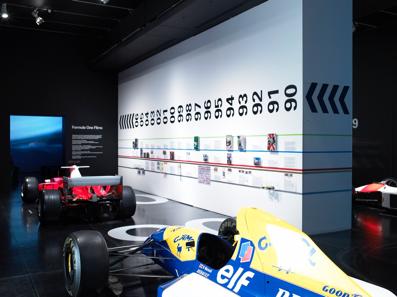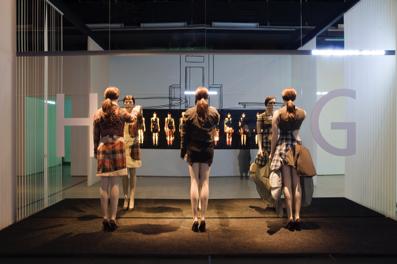
6 minute read
Chalayan and Christian Louboutin
from tame wicked
commerce, which had been one of the founding principles of the Design Museum.
3.7 Experience-Based Exhibitions: Verner Panton, Hussein
Advertisement
Chalayan and Christian Louboutin
A new focus on education and audience engagement inspired new curatorial approaches at the museum. A move towards more experience-based exhibitions connected to a broader shift discussed Chapter 2 (2.7). Earlier exhibitions at the museum had first tested this approach. In 1999 an exhibition, Verner Panton: Light and Colour (17 June - 10 October 1999) had explored the work of the mid-twentieth century Danish designer. It was conceived in two parts. The first section, designed by Tom Dixon, explored the biography of the designer and featured interiors, furniture, textiles and lighting, placing Panton’s work within the context of mid-century Scandinavian design. The second section of the exhibition recreated an immersive, ‘hypnotic’ installation consisting of eight rooms, each containing only furniture and products of a single colour, and together forming a vivid spectrum of yellow, orange, red, magenta, violet, blue, turquoise and green. The aim of the immersive installation was to communicate Panton’s influential colour philosophy, a philosophy that underpinned all of his work. The installation allowed a glimpse inside the designer’s mind, not through carefully selected objects placed on plinths and thoughtfully worded captions, but through the sheer exuberance and audacity of the display. Design critic Lesley Jackson reviewing the exhibition for The Guardian in 1999 commented; “The recollection of this exhibition has buoyed me up ever since. Now others have the chance to have their minds expanded at the Design Museum, complete with this remarkable installation.”363
The exhibition demonstrated the potential for exhibitions to employ ideas of immersion and spectacle to engage audiences. This approach
363
Lesley Jackson, ‘Verner Panton: Light and Colour’ Exhibition review, The Guardian, 1999, Personal Archive.
connected to developments more generally in museums and to exhibitions that were experimenting with new display strategies to engage audiences.
Fig. 42: The colour rooms in Verner Panton: Light and Colour at the Design Museum, 1999. Curated by Donna Loveday. Exhibition design: Tom Dixon.
In 2009 the Design Museum staged Super Contemporary (3 June - 4 October 2009). The exhibition, curated by Daniel Charny, who had been responsible for establishing the Aram Gallery in 2002, celebrated the creative spirit of London and its reputation as a beacon of design. At the centre of the exhibition were fifteen new commissions from contemporary London-based designers including David Adjaye, Barber Osgerby, Tom Dixon, Thomas Heatherwick and Paul Smith whose brief was to give something back to the city where they made their name. A timeline beginning in the 1960s charted defining moments in the development of design in London mapping the locations of key projects, studios and networks within the city. The timeline had to accommodate a range of material and the method of display chosen was a system of wooden ‘tracks’ that ran the perimeter of the main gallery. Each track had three parallel grooves allowing facts and figures, caption artwork and objects to be slotted in according to discipline and chronology. The display system

was also used as the basis for all related print material. Fig. 43: Super Contemporary at the Design Museum, 2009 Curated by Daniel Charny. Exhibition design: Martino Gamper. Graphic design: Bibliothèque.
The museum had employed the design device of the timeline in earlier exhibitions. In 2006 the exhibition, Formula One: The Great Design Race (1 July - 29 October 2006) had featured a timeline designed by exhibition and graphic designer Morag Myerscough that wrapped around the perimeter walls of the entire gallery. The design device enabled an extensive range of material communicating the history Formula One racing to be displayed. As the co-curator of the exhibition, I saw the potential of the timeline to present a wide range of historical material uncovered during archive research but which would allow the visitor to access selected
material as they moved through the exhibition.

Fig. 44: Formula One: The Great Design Race at the Design Museum, 2006.Co-curated by Alicia Pivaro and Donna Loveday. Exhibition and Graphic Design: Studio Myerscough.
Two fashion exhibitions created a new type of designed environment at the museum. The exhibition, Hussein Chalayan: From fashion and back (22 January - 17 May 2009) was the first comprehensive presentation of Chalayan’s work in the UK. Spanning fifteen years of experimental projects, the exhibition explored the designer’s creative approach, his inspirations and the many themes which influence his work ranging from genetics and technological progress to displacement, migrancy and cultural identity. Chalayan creates event spaces in the form of films, installations and exhibitions, as well as experimenting with new and innovative materials and techniques with his work extending to conceptual and technological laser and film projects alongside his bi-annual fashion collections.364
364 Design Museum Bulletin, November - February 2008, Personal Archive.
The curatorial concept adopted a conceptual approach with a series of immersive installations recreating seminal collections to show how the designer used clothing as a site of exploration, to express concepts and make them accessible to a wider audience. The exhibition environment was conceived as an airline departure lounge, and with the absence of any wall text, visitors were encouraged to move through a series of spaces to fully experience the work presented. An exhibition guide was issued to visitors with information about each of the collections and projects but many preferred to walk through the exhibition before making reference to the guide. The exhibition received critical acclaim and was selected as Critics Choice in Time Out for January and March 2009. The Telegraph commented, “this exhibition offers not only a chance to see Chalayan’s daring dresses up close - but also a rare insight into his unusual creative process.”365

Fig. 45: Hussein Chalayan; From fashion and back at the Design Museum, 2009. Curated by Donna Loveday, Exhibition design: Block Architecture, Graphic design: Abake.
365
Harriet Quick, ‘From Fashion And Back: Hussein Chalayan's latest exhibition’, The Telegraph, 20 January 2009. Available at: http://fashion.telegraph.co.uk/news-features/ TMG4299978/From-Fashion-And-Back-Hussein-Chalayans-latest-exhibition.html (Accessed 20.10.17)
The exhibition Christian Louboutin (1 May - 9 July 2012) adopted a similar experience-based approach. As the curator I decided to appoint design agency, Household, as exhibition designers who specialised in the design of retail interiors and in creating “customer-centric experiences that disrupt.”366 The exhibition was the first UK retrospective of French shoe designer Christian Louboutin and showcased twenty years of designs and inspiration, revealing the artistry and theatricality of his shoe design from stilettos and lace-up boots to sneakers and bejewelled pumps. Drawing from the designer’s personal archive, the exhibition presented an immersive exhibition environment that examined the many sources of his creativity - shoes inspired by performance, cabaret and the showgirl; fantasy and fairy tale; art and architecture; film; landscape and travel.367
The exhibition employed a number of design devices to directly engage the visitor with the designer and his design process. A recreation of Louboutin’s studio in Paris took the visitor through every stage of the design process, revealing how a shoe is constructed, from the initial drawing and first prototype through to production in the factory. At the centre of the exhibition was a 3-D holographic performance by the burlesque performer, Dita von Teese, who appeared to be dancing in the space, the first time this type of technology had been used at the Design Museum. The exhibition went on to break all attendance records at the Design Museum and won a number of awards.368 In critical reviews of the exhibition, the curator was credited with successfully moving the visitor experience on from a “white box” exhibition to a new inspiring and
366
Household web page. Available at: https://www.household-design.com (Accessed 20.10.17).
367 Design Museum Bulletin, October 2011 - March 2012, Personal Archive.
368
The exhibition was shortlisted for Best Exhibition Design at the Design Week Awards 2013, awarded Best Exhibition Space at the World Interiors News Awards 2013 and a winner in the category for Exhibitions and Experiential Environments at the DBS Design Effectiveness Awards in 2014.

